Key Differences in Supply Chain Management and Logistics at Lulu Group
VerifiedAdded on 2022/08/11
|13
|4023
|32
Report
AI Summary
This report examines the supply chain management (SCM) and logistics operations of Lulu Group International, a major retail chain in the UAE. It begins with an introduction to SCM and logistics, highlighting their interrelation and importance. The report then provides an overview of Lulu Group, its operations, and the challenges it faces, such as transportation costs, labor costs, and environmental concerns. The research aims to determine the key differences in SCM and logistics through different theories, with objectives including defining the concepts and importance of SCM and logistics, and analyzing the differences between them. The literature review explores the concept and importance of SCM, including its role in customer service, cost reduction, and financial improvement, and the concept of logistics, including inbound and outbound logistics. The report also discusses the differences between SCM and logistics, including their processes, purposes, and job descriptions. The report is a student assignment and provides valuable insights into the practical application of SCM and logistics principles within a real-world business context. The report also references different theories such as Systemic approach and resource dependency theory.

RESEARCH
Paraphrase This Document
Need a fresh take? Get an instant paraphrase of this document with our AI Paraphraser
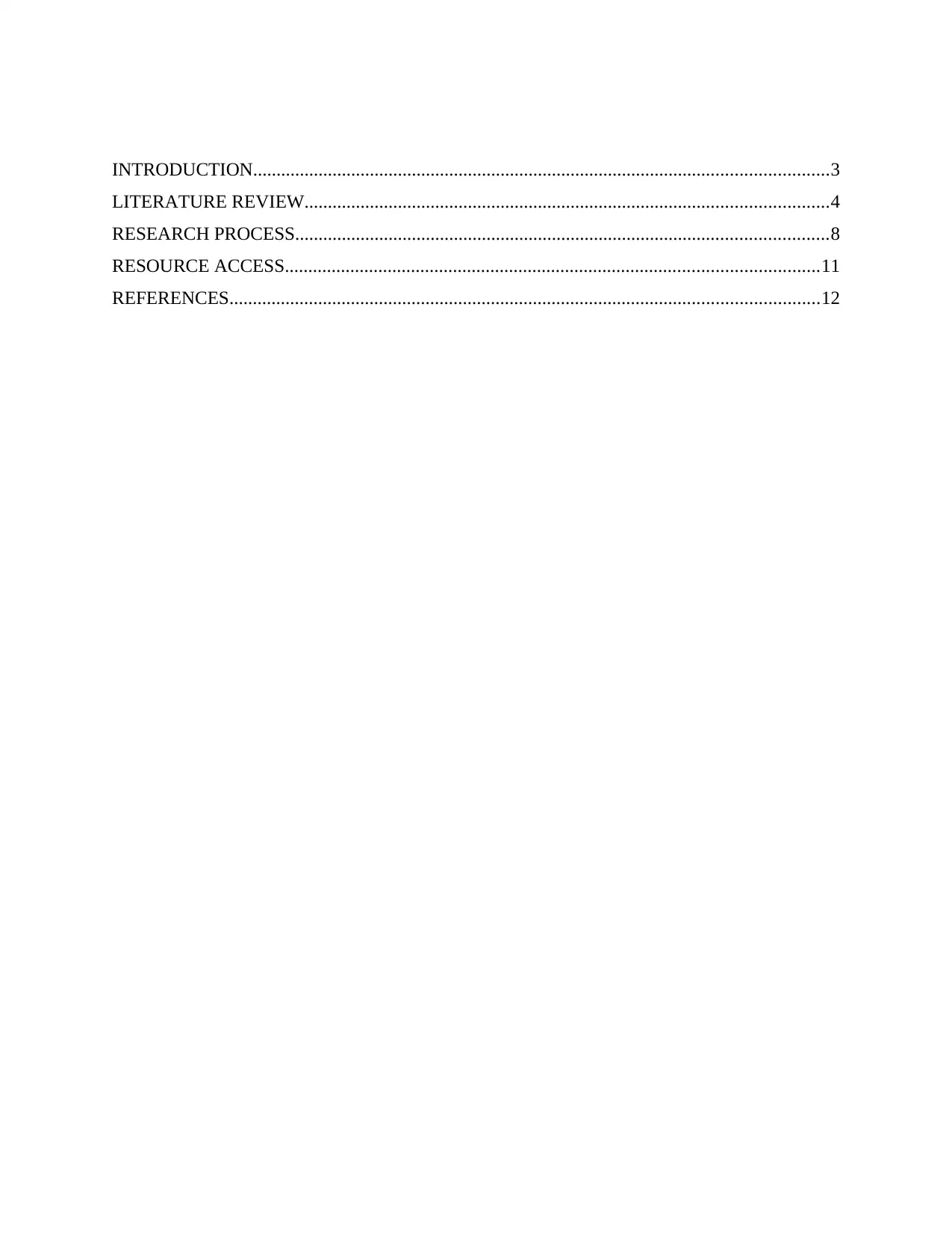
INTRODUCTION...........................................................................................................................3
LITERATURE REVIEW................................................................................................................4
RESEARCH PROCESS..................................................................................................................8
RESOURCE ACCESS..................................................................................................................11
REFERENCES..............................................................................................................................12
LITERATURE REVIEW................................................................................................................4
RESEARCH PROCESS..................................................................................................................8
RESOURCE ACCESS..................................................................................................................11
REFERENCES..............................................................................................................................12
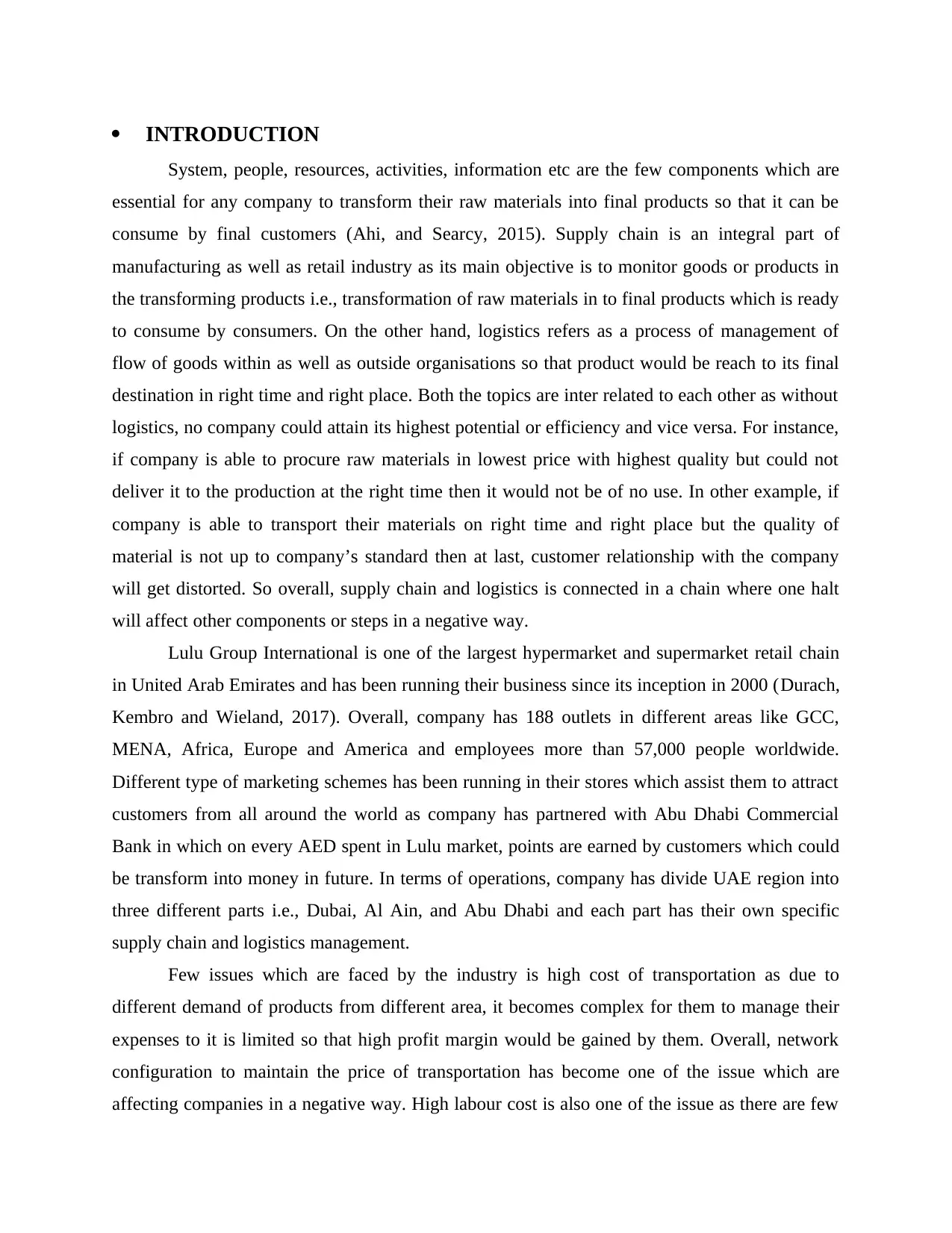
INTRODUCTION
System, people, resources, activities, information etc are the few components which are
essential for any company to transform their raw materials into final products so that it can be
consume by final customers (Ahi, and Searcy, 2015). Supply chain is an integral part of
manufacturing as well as retail industry as its main objective is to monitor goods or products in
the transforming products i.e., transformation of raw materials in to final products which is ready
to consume by consumers. On the other hand, logistics refers as a process of management of
flow of goods within as well as outside organisations so that product would be reach to its final
destination in right time and right place. Both the topics are inter related to each other as without
logistics, no company could attain its highest potential or efficiency and vice versa. For instance,
if company is able to procure raw materials in lowest price with highest quality but could not
deliver it to the production at the right time then it would not be of no use. In other example, if
company is able to transport their materials on right time and right place but the quality of
material is not up to company’s standard then at last, customer relationship with the company
will get distorted. So overall, supply chain and logistics is connected in a chain where one halt
will affect other components or steps in a negative way.
Lulu Group International is one of the largest hypermarket and supermarket retail chain
in United Arab Emirates and has been running their business since its inception in 2000 (Durach,
Kembro and Wieland, 2017). Overall, company has 188 outlets in different areas like GCC,
MENA, Africa, Europe and America and employees more than 57,000 people worldwide.
Different type of marketing schemes has been running in their stores which assist them to attract
customers from all around the world as company has partnered with Abu Dhabi Commercial
Bank in which on every AED spent in Lulu market, points are earned by customers which could
be transform into money in future. In terms of operations, company has divide UAE region into
three different parts i.e., Dubai, Al Ain, and Abu Dhabi and each part has their own specific
supply chain and logistics management.
Few issues which are faced by the industry is high cost of transportation as due to
different demand of products from different area, it becomes complex for them to manage their
expenses to it is limited so that high profit margin would be gained by them. Overall, network
configuration to maintain the price of transportation has become one of the issue which are
affecting companies in a negative way. High labour cost is also one of the issue as there are few
System, people, resources, activities, information etc are the few components which are
essential for any company to transform their raw materials into final products so that it can be
consume by final customers (Ahi, and Searcy, 2015). Supply chain is an integral part of
manufacturing as well as retail industry as its main objective is to monitor goods or products in
the transforming products i.e., transformation of raw materials in to final products which is ready
to consume by consumers. On the other hand, logistics refers as a process of management of
flow of goods within as well as outside organisations so that product would be reach to its final
destination in right time and right place. Both the topics are inter related to each other as without
logistics, no company could attain its highest potential or efficiency and vice versa. For instance,
if company is able to procure raw materials in lowest price with highest quality but could not
deliver it to the production at the right time then it would not be of no use. In other example, if
company is able to transport their materials on right time and right place but the quality of
material is not up to company’s standard then at last, customer relationship with the company
will get distorted. So overall, supply chain and logistics is connected in a chain where one halt
will affect other components or steps in a negative way.
Lulu Group International is one of the largest hypermarket and supermarket retail chain
in United Arab Emirates and has been running their business since its inception in 2000 (Durach,
Kembro and Wieland, 2017). Overall, company has 188 outlets in different areas like GCC,
MENA, Africa, Europe and America and employees more than 57,000 people worldwide.
Different type of marketing schemes has been running in their stores which assist them to attract
customers from all around the world as company has partnered with Abu Dhabi Commercial
Bank in which on every AED spent in Lulu market, points are earned by customers which could
be transform into money in future. In terms of operations, company has divide UAE region into
three different parts i.e., Dubai, Al Ain, and Abu Dhabi and each part has their own specific
supply chain and logistics management.
Few issues which are faced by the industry is high cost of transportation as due to
different demand of products from different area, it becomes complex for them to manage their
expenses to it is limited so that high profit margin would be gained by them. Overall, network
configuration to maintain the price of transportation has become one of the issue which are
affecting companies in a negative way. High labour cost is also one of the issue as there are few
⊘ This is a preview!⊘
Do you want full access?
Subscribe today to unlock all pages.

Trusted by 1+ million students worldwide
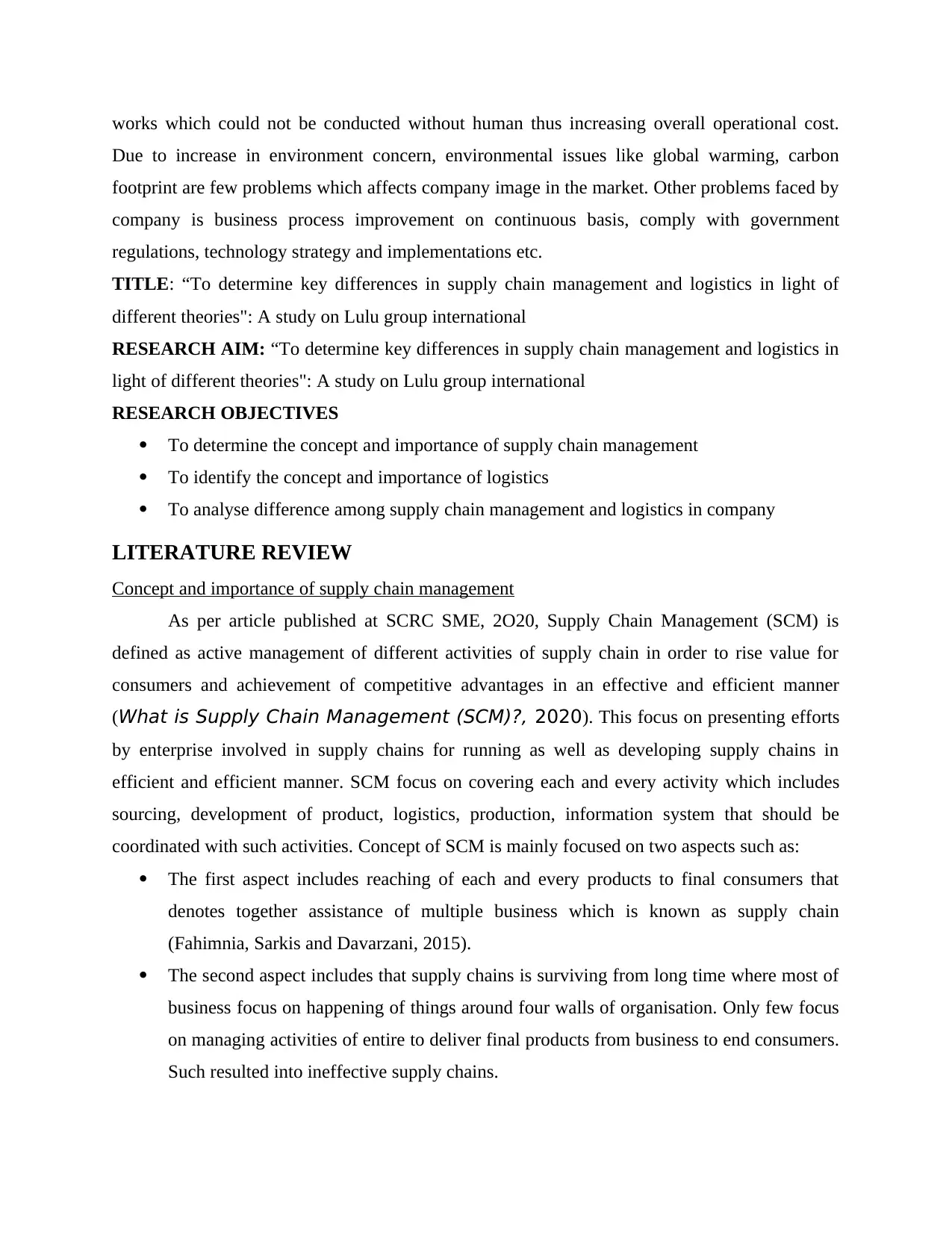
works which could not be conducted without human thus increasing overall operational cost.
Due to increase in environment concern, environmental issues like global warming, carbon
footprint are few problems which affects company image in the market. Other problems faced by
company is business process improvement on continuous basis, comply with government
regulations, technology strategy and implementations etc.
TITLE: “To determine key differences in supply chain management and logistics in light of
different theories": A study on Lulu group international
RESEARCH AIM: “To determine key differences in supply chain management and logistics in
light of different theories": A study on Lulu group international
RESEARCH OBJECTIVES
To determine the concept and importance of supply chain management
To identify the concept and importance of logistics
To analyse difference among supply chain management and logistics in company
LITERATURE REVIEW
Concept and importance of supply chain management
As per article published at SCRC SME, 2O20, Supply Chain Management (SCM) is
defined as active management of different activities of supply chain in order to rise value for
consumers and achievement of competitive advantages in an effective and efficient manner
(What is Supply Chain Management (SCM)?, 2020). This focus on presenting efforts
by enterprise involved in supply chains for running as well as developing supply chains in
efficient and efficient manner. SCM focus on covering each and every activity which includes
sourcing, development of product, logistics, production, information system that should be
coordinated with such activities. Concept of SCM is mainly focused on two aspects such as:
The first aspect includes reaching of each and every products to final consumers that
denotes together assistance of multiple business which is known as supply chain
(Fahimnia, Sarkis and Davarzani, 2015).
The second aspect includes that supply chains is surviving from long time where most of
business focus on happening of things around four walls of organisation. Only few focus
on managing activities of entire to deliver final products from business to end consumers.
Such resulted into ineffective supply chains.
Due to increase in environment concern, environmental issues like global warming, carbon
footprint are few problems which affects company image in the market. Other problems faced by
company is business process improvement on continuous basis, comply with government
regulations, technology strategy and implementations etc.
TITLE: “To determine key differences in supply chain management and logistics in light of
different theories": A study on Lulu group international
RESEARCH AIM: “To determine key differences in supply chain management and logistics in
light of different theories": A study on Lulu group international
RESEARCH OBJECTIVES
To determine the concept and importance of supply chain management
To identify the concept and importance of logistics
To analyse difference among supply chain management and logistics in company
LITERATURE REVIEW
Concept and importance of supply chain management
As per article published at SCRC SME, 2O20, Supply Chain Management (SCM) is
defined as active management of different activities of supply chain in order to rise value for
consumers and achievement of competitive advantages in an effective and efficient manner
(What is Supply Chain Management (SCM)?, 2020). This focus on presenting efforts
by enterprise involved in supply chains for running as well as developing supply chains in
efficient and efficient manner. SCM focus on covering each and every activity which includes
sourcing, development of product, logistics, production, information system that should be
coordinated with such activities. Concept of SCM is mainly focused on two aspects such as:
The first aspect includes reaching of each and every products to final consumers that
denotes together assistance of multiple business which is known as supply chain
(Fahimnia, Sarkis and Davarzani, 2015).
The second aspect includes that supply chains is surviving from long time where most of
business focus on happening of things around four walls of organisation. Only few focus
on managing activities of entire to deliver final products from business to end consumers.
Such resulted into ineffective supply chains.
Paraphrase This Document
Need a fresh take? Get an instant paraphrase of this document with our AI Paraphraser
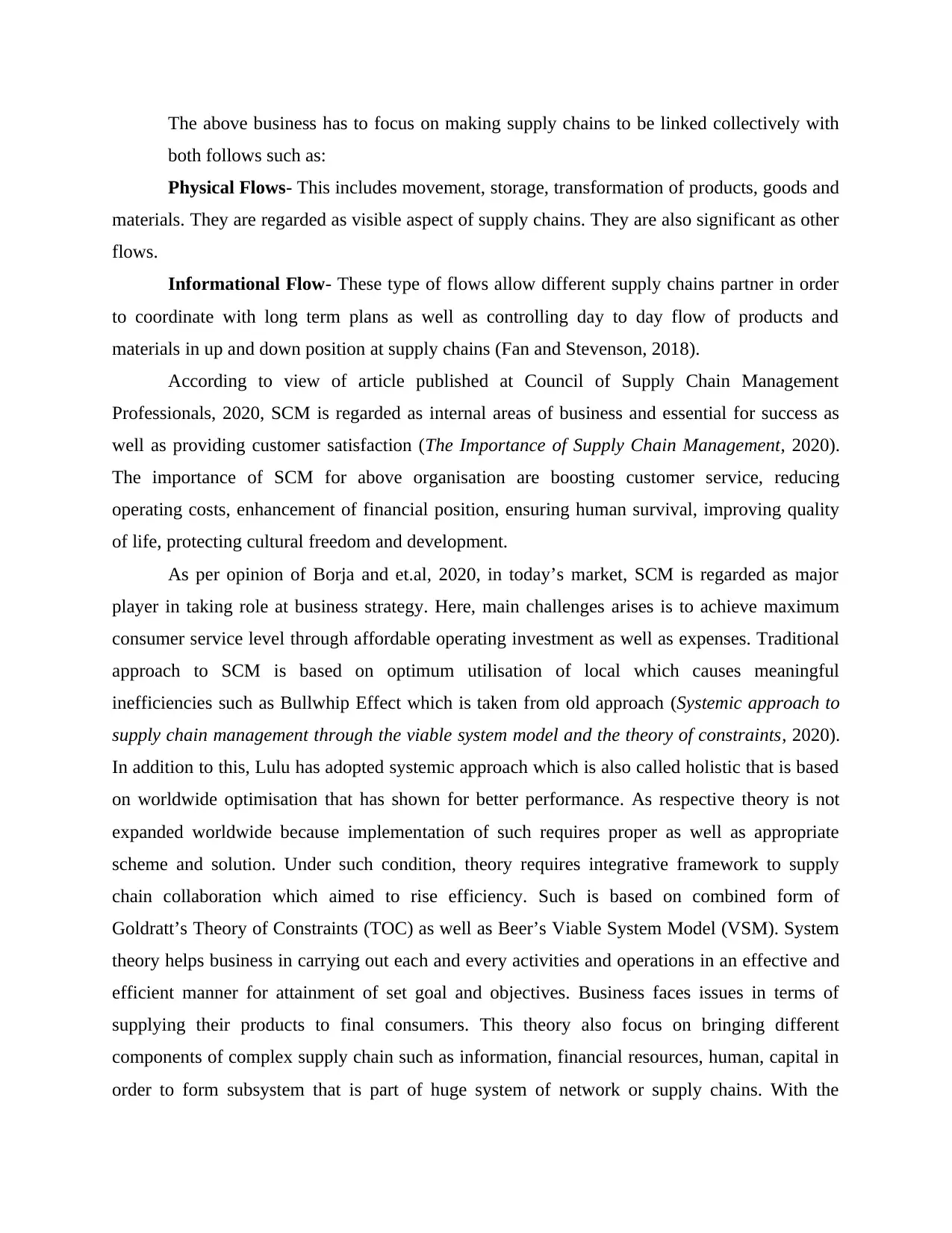
The above business has to focus on making supply chains to be linked collectively with
both follows such as:
Physical Flows- This includes movement, storage, transformation of products, goods and
materials. They are regarded as visible aspect of supply chains. They are also significant as other
flows.
Informational Flow- These type of flows allow different supply chains partner in order
to coordinate with long term plans as well as controlling day to day flow of products and
materials in up and down position at supply chains (Fan and Stevenson, 2018).
According to view of article published at Council of Supply Chain Management
Professionals, 2020, SCM is regarded as internal areas of business and essential for success as
well as providing customer satisfaction (The Importance of Supply Chain Management, 2020).
The importance of SCM for above organisation are boosting customer service, reducing
operating costs, enhancement of financial position, ensuring human survival, improving quality
of life, protecting cultural freedom and development.
As per opinion of Borja and et.al, 2020, in today’s market, SCM is regarded as major
player in taking role at business strategy. Here, main challenges arises is to achieve maximum
consumer service level through affordable operating investment as well as expenses. Traditional
approach to SCM is based on optimum utilisation of local which causes meaningful
inefficiencies such as Bullwhip Effect which is taken from old approach (Systemic approach to
supply chain management through the viable system model and the theory of constraints, 2020).
In addition to this, Lulu has adopted systemic approach which is also called holistic that is based
on worldwide optimisation that has shown for better performance. As respective theory is not
expanded worldwide because implementation of such requires proper as well as appropriate
scheme and solution. Under such condition, theory requires integrative framework to supply
chain collaboration which aimed to rise efficiency. Such is based on combined form of
Goldratt’s Theory of Constraints (TOC) as well as Beer’s Viable System Model (VSM). System
theory helps business in carrying out each and every activities and operations in an effective and
efficient manner for attainment of set goal and objectives. Business faces issues in terms of
supplying their products to final consumers. This theory also focus on bringing different
components of complex supply chain such as information, financial resources, human, capital in
order to form subsystem that is part of huge system of network or supply chains. With the
both follows such as:
Physical Flows- This includes movement, storage, transformation of products, goods and
materials. They are regarded as visible aspect of supply chains. They are also significant as other
flows.
Informational Flow- These type of flows allow different supply chains partner in order
to coordinate with long term plans as well as controlling day to day flow of products and
materials in up and down position at supply chains (Fan and Stevenson, 2018).
According to view of article published at Council of Supply Chain Management
Professionals, 2020, SCM is regarded as internal areas of business and essential for success as
well as providing customer satisfaction (The Importance of Supply Chain Management, 2020).
The importance of SCM for above organisation are boosting customer service, reducing
operating costs, enhancement of financial position, ensuring human survival, improving quality
of life, protecting cultural freedom and development.
As per opinion of Borja and et.al, 2020, in today’s market, SCM is regarded as major
player in taking role at business strategy. Here, main challenges arises is to achieve maximum
consumer service level through affordable operating investment as well as expenses. Traditional
approach to SCM is based on optimum utilisation of local which causes meaningful
inefficiencies such as Bullwhip Effect which is taken from old approach (Systemic approach to
supply chain management through the viable system model and the theory of constraints, 2020).
In addition to this, Lulu has adopted systemic approach which is also called holistic that is based
on worldwide optimisation that has shown for better performance. As respective theory is not
expanded worldwide because implementation of such requires proper as well as appropriate
scheme and solution. Under such condition, theory requires integrative framework to supply
chain collaboration which aimed to rise efficiency. Such is based on combined form of
Goldratt’s Theory of Constraints (TOC) as well as Beer’s Viable System Model (VSM). System
theory helps business in carrying out each and every activities and operations in an effective and
efficient manner for attainment of set goal and objectives. Business faces issues in terms of
supplying their products to final consumers. This theory also focus on bringing different
components of complex supply chain such as information, financial resources, human, capital in
order to form subsystem that is part of huge system of network or supply chains. With the
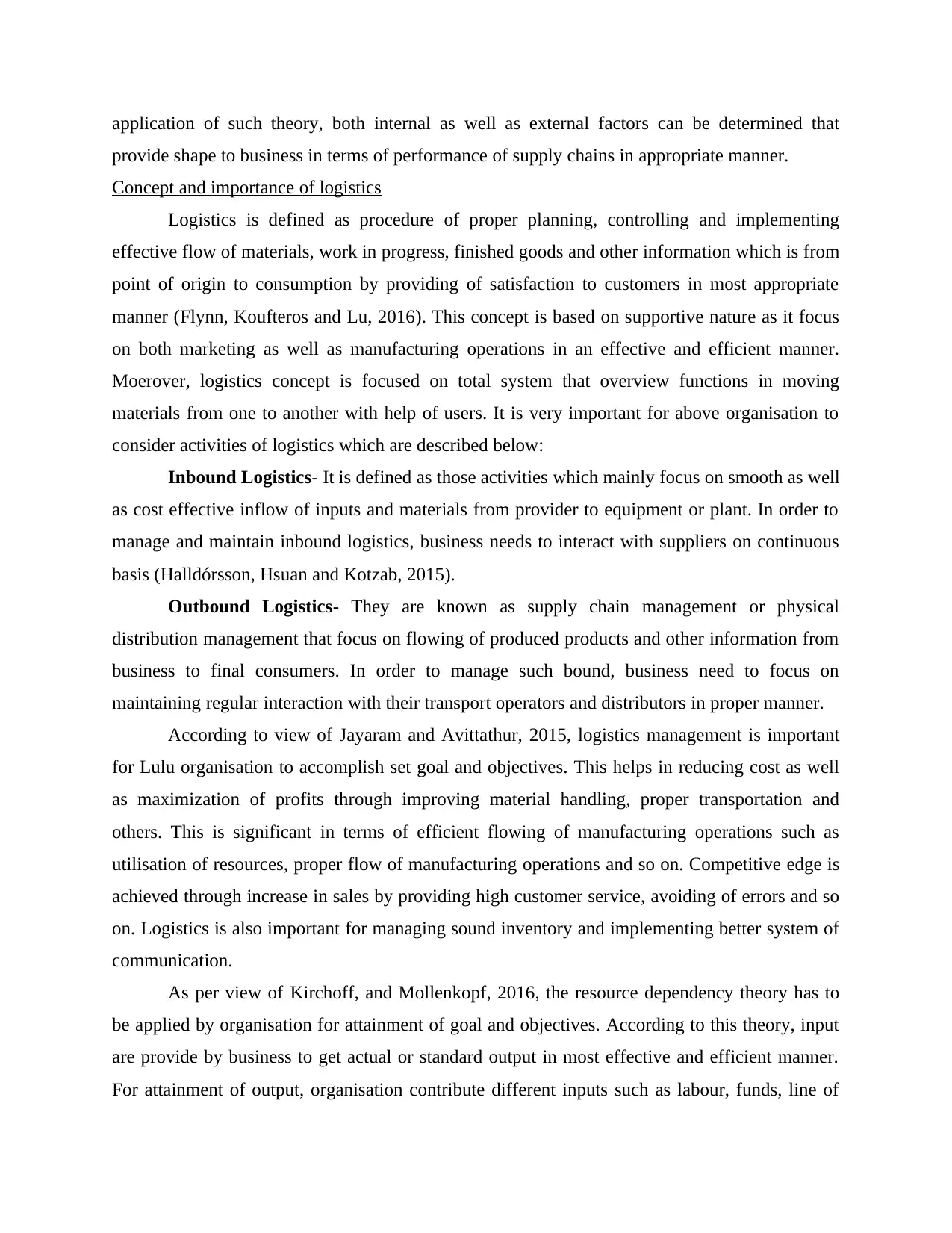
application of such theory, both internal as well as external factors can be determined that
provide shape to business in terms of performance of supply chains in appropriate manner.
Concept and importance of logistics
Logistics is defined as procedure of proper planning, controlling and implementing
effective flow of materials, work in progress, finished goods and other information which is from
point of origin to consumption by providing of satisfaction to customers in most appropriate
manner (Flynn, Koufteros and Lu, 2016). This concept is based on supportive nature as it focus
on both marketing as well as manufacturing operations in an effective and efficient manner.
Moerover, logistics concept is focused on total system that overview functions in moving
materials from one to another with help of users. It is very important for above organisation to
consider activities of logistics which are described below:
Inbound Logistics- It is defined as those activities which mainly focus on smooth as well
as cost effective inflow of inputs and materials from provider to equipment or plant. In order to
manage and maintain inbound logistics, business needs to interact with suppliers on continuous
basis (Halldórsson, Hsuan and Kotzab, 2015).
Outbound Logistics- They are known as supply chain management or physical
distribution management that focus on flowing of produced products and other information from
business to final consumers. In order to manage such bound, business need to focus on
maintaining regular interaction with their transport operators and distributors in proper manner.
According to view of Jayaram and Avittathur, 2015, logistics management is important
for Lulu organisation to accomplish set goal and objectives. This helps in reducing cost as well
as maximization of profits through improving material handling, proper transportation and
others. This is significant in terms of efficient flowing of manufacturing operations such as
utilisation of resources, proper flow of manufacturing operations and so on. Competitive edge is
achieved through increase in sales by providing high customer service, avoiding of errors and so
on. Logistics is also important for managing sound inventory and implementing better system of
communication.
As per view of Kirchoff, and Mollenkopf, 2016, the resource dependency theory has to
be applied by organisation for attainment of goal and objectives. According to this theory, input
are provide by business to get actual or standard output in most effective and efficient manner.
For attainment of output, organisation contribute different inputs such as labour, funds, line of
provide shape to business in terms of performance of supply chains in appropriate manner.
Concept and importance of logistics
Logistics is defined as procedure of proper planning, controlling and implementing
effective flow of materials, work in progress, finished goods and other information which is from
point of origin to consumption by providing of satisfaction to customers in most appropriate
manner (Flynn, Koufteros and Lu, 2016). This concept is based on supportive nature as it focus
on both marketing as well as manufacturing operations in an effective and efficient manner.
Moerover, logistics concept is focused on total system that overview functions in moving
materials from one to another with help of users. It is very important for above organisation to
consider activities of logistics which are described below:
Inbound Logistics- It is defined as those activities which mainly focus on smooth as well
as cost effective inflow of inputs and materials from provider to equipment or plant. In order to
manage and maintain inbound logistics, business needs to interact with suppliers on continuous
basis (Halldórsson, Hsuan and Kotzab, 2015).
Outbound Logistics- They are known as supply chain management or physical
distribution management that focus on flowing of produced products and other information from
business to final consumers. In order to manage such bound, business need to focus on
maintaining regular interaction with their transport operators and distributors in proper manner.
According to view of Jayaram and Avittathur, 2015, logistics management is important
for Lulu organisation to accomplish set goal and objectives. This helps in reducing cost as well
as maximization of profits through improving material handling, proper transportation and
others. This is significant in terms of efficient flowing of manufacturing operations such as
utilisation of resources, proper flow of manufacturing operations and so on. Competitive edge is
achieved through increase in sales by providing high customer service, avoiding of errors and so
on. Logistics is also important for managing sound inventory and implementing better system of
communication.
As per view of Kirchoff, and Mollenkopf, 2016, the resource dependency theory has to
be applied by organisation for attainment of goal and objectives. According to this theory, input
are provide by business to get actual or standard output in most effective and efficient manner.
For attainment of output, organisation contribute different inputs such as labour, funds, line of
⊘ This is a preview!⊘
Do you want full access?
Subscribe today to unlock all pages.

Trusted by 1+ million students worldwide
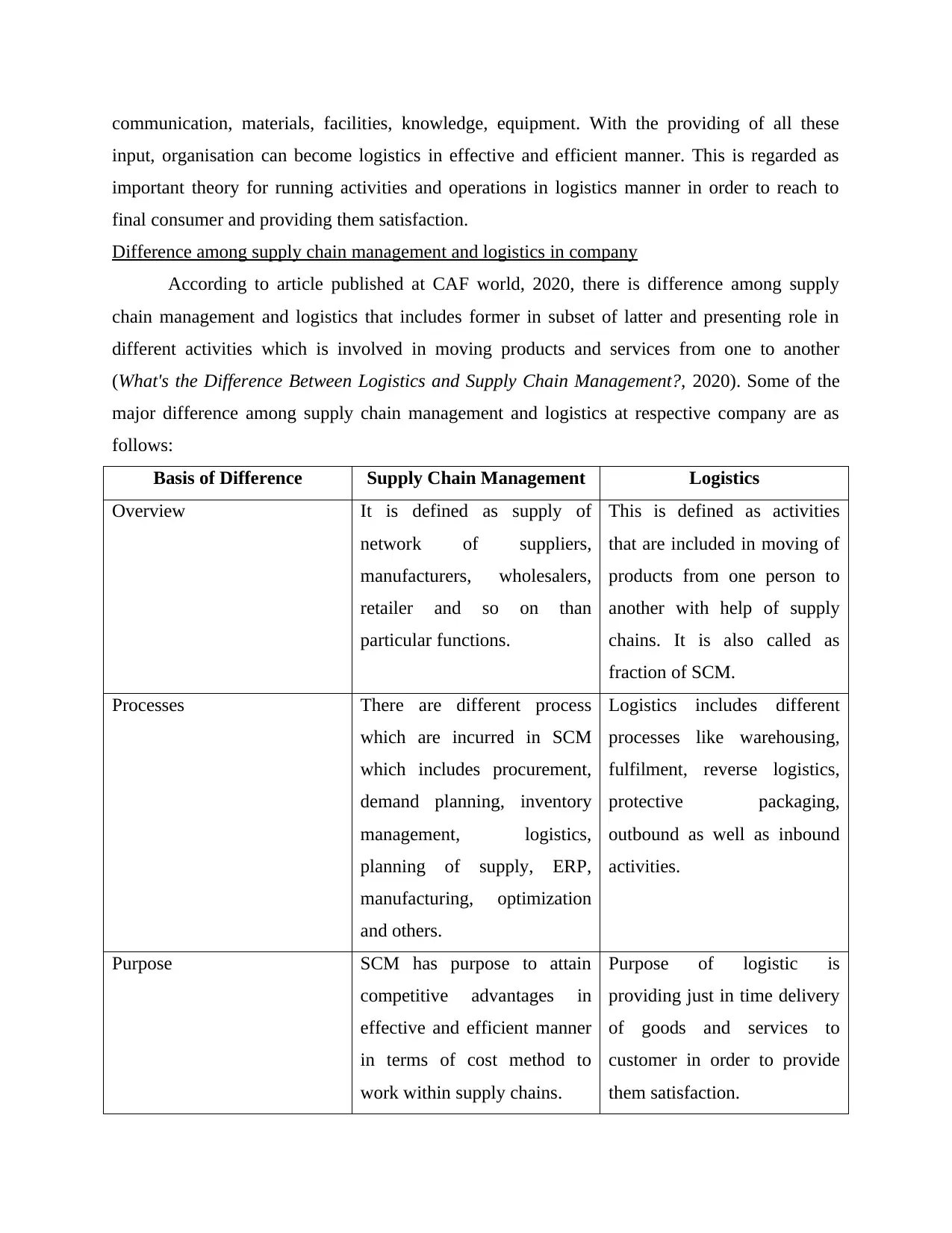
communication, materials, facilities, knowledge, equipment. With the providing of all these
input, organisation can become logistics in effective and efficient manner. This is regarded as
important theory for running activities and operations in logistics manner in order to reach to
final consumer and providing them satisfaction.
Difference among supply chain management and logistics in company
According to article published at CAF world, 2020, there is difference among supply
chain management and logistics that includes former in subset of latter and presenting role in
different activities which is involved in moving products and services from one to another
(What's the Difference Between Logistics and Supply Chain Management?, 2020). Some of the
major difference among supply chain management and logistics at respective company are as
follows:
Basis of Difference Supply Chain Management Logistics
Overview It is defined as supply of
network of suppliers,
manufacturers, wholesalers,
retailer and so on than
particular functions.
This is defined as activities
that are included in moving of
products from one person to
another with help of supply
chains. It is also called as
fraction of SCM.
Processes There are different process
which are incurred in SCM
which includes procurement,
demand planning, inventory
management, logistics,
planning of supply, ERP,
manufacturing, optimization
and others.
Logistics includes different
processes like warehousing,
fulfilment, reverse logistics,
protective packaging,
outbound as well as inbound
activities.
Purpose SCM has purpose to attain
competitive advantages in
effective and efficient manner
in terms of cost method to
work within supply chains.
Purpose of logistic is
providing just in time delivery
of goods and services to
customer in order to provide
them satisfaction.
input, organisation can become logistics in effective and efficient manner. This is regarded as
important theory for running activities and operations in logistics manner in order to reach to
final consumer and providing them satisfaction.
Difference among supply chain management and logistics in company
According to article published at CAF world, 2020, there is difference among supply
chain management and logistics that includes former in subset of latter and presenting role in
different activities which is involved in moving products and services from one to another
(What's the Difference Between Logistics and Supply Chain Management?, 2020). Some of the
major difference among supply chain management and logistics at respective company are as
follows:
Basis of Difference Supply Chain Management Logistics
Overview It is defined as supply of
network of suppliers,
manufacturers, wholesalers,
retailer and so on than
particular functions.
This is defined as activities
that are included in moving of
products from one person to
another with help of supply
chains. It is also called as
fraction of SCM.
Processes There are different process
which are incurred in SCM
which includes procurement,
demand planning, inventory
management, logistics,
planning of supply, ERP,
manufacturing, optimization
and others.
Logistics includes different
processes like warehousing,
fulfilment, reverse logistics,
protective packaging,
outbound as well as inbound
activities.
Purpose SCM has purpose to attain
competitive advantages in
effective and efficient manner
in terms of cost method to
work within supply chains.
Purpose of logistic is
providing just in time delivery
of goods and services to
customer in order to provide
them satisfaction.
Paraphrase This Document
Need a fresh take? Get an instant paraphrase of this document with our AI Paraphraser
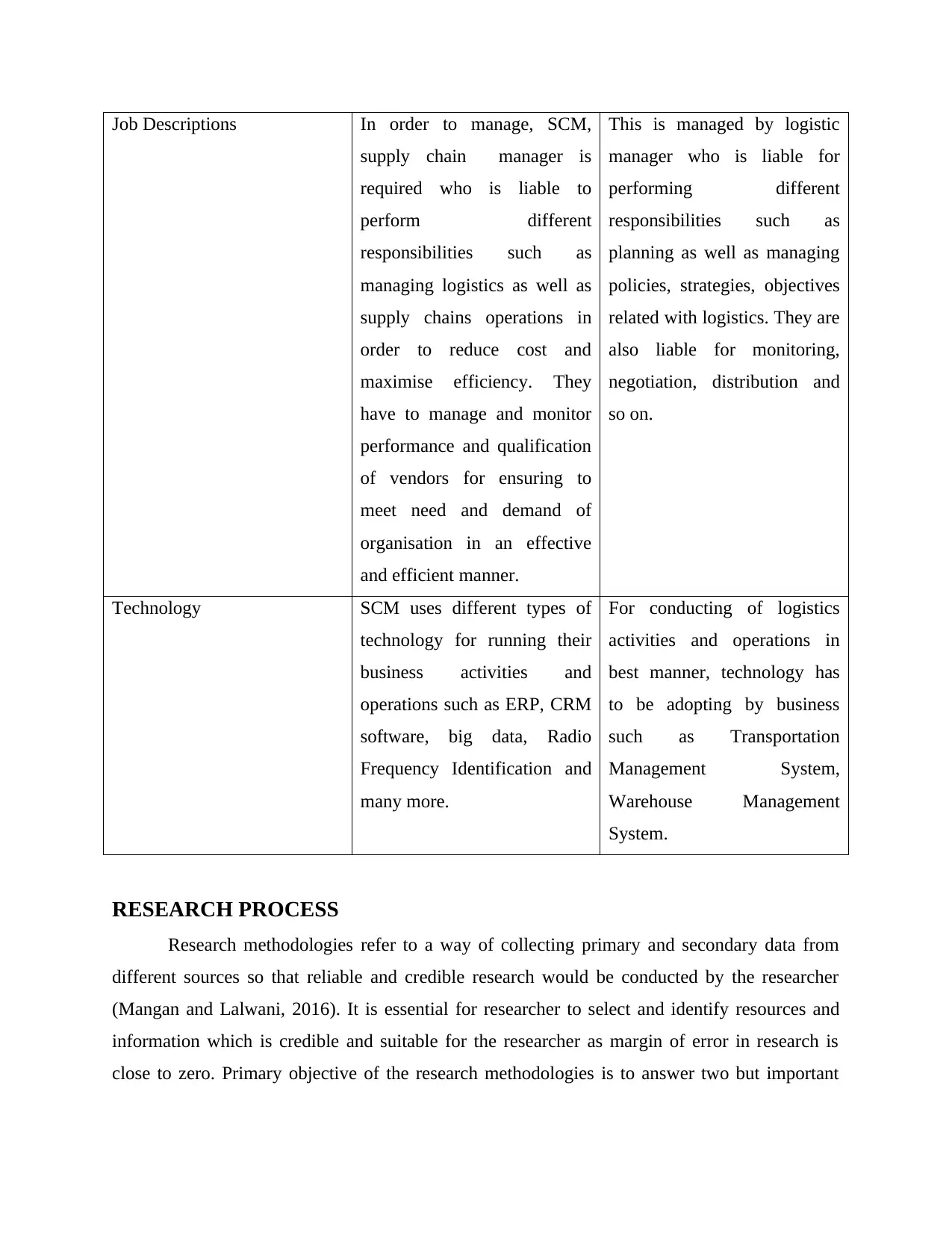
Job Descriptions In order to manage, SCM,
supply chain manager is
required who is liable to
perform different
responsibilities such as
managing logistics as well as
supply chains operations in
order to reduce cost and
maximise efficiency. They
have to manage and monitor
performance and qualification
of vendors for ensuring to
meet need and demand of
organisation in an effective
and efficient manner.
This is managed by logistic
manager who is liable for
performing different
responsibilities such as
planning as well as managing
policies, strategies, objectives
related with logistics. They are
also liable for monitoring,
negotiation, distribution and
so on.
Technology SCM uses different types of
technology for running their
business activities and
operations such as ERP, CRM
software, big data, Radio
Frequency Identification and
many more.
For conducting of logistics
activities and operations in
best manner, technology has
to be adopting by business
such as Transportation
Management System,
Warehouse Management
System.
RESEARCH PROCESS
Research methodologies refer to a way of collecting primary and secondary data from
different sources so that reliable and credible research would be conducted by the researcher
(Mangan and Lalwani, 2016). It is essential for researcher to select and identify resources and
information which is credible and suitable for the researcher as margin of error in research is
close to zero. Primary objective of the research methodologies is to answer two but important
supply chain manager is
required who is liable to
perform different
responsibilities such as
managing logistics as well as
supply chains operations in
order to reduce cost and
maximise efficiency. They
have to manage and monitor
performance and qualification
of vendors for ensuring to
meet need and demand of
organisation in an effective
and efficient manner.
This is managed by logistic
manager who is liable for
performing different
responsibilities such as
planning as well as managing
policies, strategies, objectives
related with logistics. They are
also liable for monitoring,
negotiation, distribution and
so on.
Technology SCM uses different types of
technology for running their
business activities and
operations such as ERP, CRM
software, big data, Radio
Frequency Identification and
many more.
For conducting of logistics
activities and operations in
best manner, technology has
to be adopting by business
such as Transportation
Management System,
Warehouse Management
System.
RESEARCH PROCESS
Research methodologies refer to a way of collecting primary and secondary data from
different sources so that reliable and credible research would be conducted by the researcher
(Mangan and Lalwani, 2016). It is essential for researcher to select and identify resources and
information which is credible and suitable for the researcher as margin of error in research is
close to zero. Primary objective of the research methodologies is to answer two but important
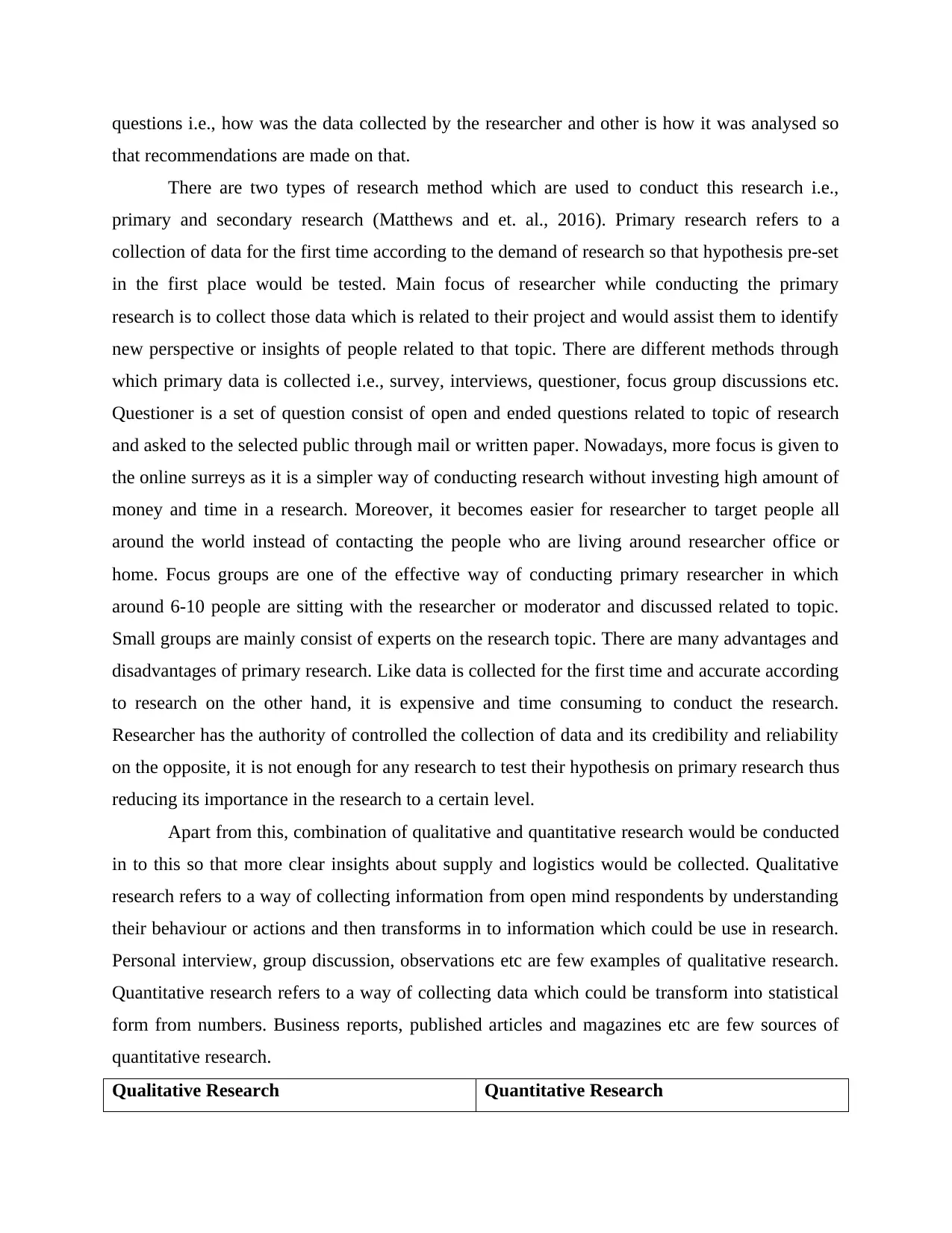
questions i.e., how was the data collected by the researcher and other is how it was analysed so
that recommendations are made on that.
There are two types of research method which are used to conduct this research i.e.,
primary and secondary research (Matthews and et. al., 2016). Primary research refers to a
collection of data for the first time according to the demand of research so that hypothesis pre-set
in the first place would be tested. Main focus of researcher while conducting the primary
research is to collect those data which is related to their project and would assist them to identify
new perspective or insights of people related to that topic. There are different methods through
which primary data is collected i.e., survey, interviews, questioner, focus group discussions etc.
Questioner is a set of question consist of open and ended questions related to topic of research
and asked to the selected public through mail or written paper. Nowadays, more focus is given to
the online surreys as it is a simpler way of conducting research without investing high amount of
money and time in a research. Moreover, it becomes easier for researcher to target people all
around the world instead of contacting the people who are living around researcher office or
home. Focus groups are one of the effective way of conducting primary researcher in which
around 6-10 people are sitting with the researcher or moderator and discussed related to topic.
Small groups are mainly consist of experts on the research topic. There are many advantages and
disadvantages of primary research. Like data is collected for the first time and accurate according
to research on the other hand, it is expensive and time consuming to conduct the research.
Researcher has the authority of controlled the collection of data and its credibility and reliability
on the opposite, it is not enough for any research to test their hypothesis on primary research thus
reducing its importance in the research to a certain level.
Apart from this, combination of qualitative and quantitative research would be conducted
in to this so that more clear insights about supply and logistics would be collected. Qualitative
research refers to a way of collecting information from open mind respondents by understanding
their behaviour or actions and then transforms in to information which could be use in research.
Personal interview, group discussion, observations etc are few examples of qualitative research.
Quantitative research refers to a way of collecting data which could be transform into statistical
form from numbers. Business reports, published articles and magazines etc are few sources of
quantitative research.
Qualitative Research Quantitative Research
that recommendations are made on that.
There are two types of research method which are used to conduct this research i.e.,
primary and secondary research (Matthews and et. al., 2016). Primary research refers to a
collection of data for the first time according to the demand of research so that hypothesis pre-set
in the first place would be tested. Main focus of researcher while conducting the primary
research is to collect those data which is related to their project and would assist them to identify
new perspective or insights of people related to that topic. There are different methods through
which primary data is collected i.e., survey, interviews, questioner, focus group discussions etc.
Questioner is a set of question consist of open and ended questions related to topic of research
and asked to the selected public through mail or written paper. Nowadays, more focus is given to
the online surreys as it is a simpler way of conducting research without investing high amount of
money and time in a research. Moreover, it becomes easier for researcher to target people all
around the world instead of contacting the people who are living around researcher office or
home. Focus groups are one of the effective way of conducting primary researcher in which
around 6-10 people are sitting with the researcher or moderator and discussed related to topic.
Small groups are mainly consist of experts on the research topic. There are many advantages and
disadvantages of primary research. Like data is collected for the first time and accurate according
to research on the other hand, it is expensive and time consuming to conduct the research.
Researcher has the authority of controlled the collection of data and its credibility and reliability
on the opposite, it is not enough for any research to test their hypothesis on primary research thus
reducing its importance in the research to a certain level.
Apart from this, combination of qualitative and quantitative research would be conducted
in to this so that more clear insights about supply and logistics would be collected. Qualitative
research refers to a way of collecting information from open mind respondents by understanding
their behaviour or actions and then transforms in to information which could be use in research.
Personal interview, group discussion, observations etc are few examples of qualitative research.
Quantitative research refers to a way of collecting data which could be transform into statistical
form from numbers. Business reports, published articles and magazines etc are few sources of
quantitative research.
Qualitative Research Quantitative Research
⊘ This is a preview!⊘
Do you want full access?
Subscribe today to unlock all pages.

Trusted by 1+ million students worldwide
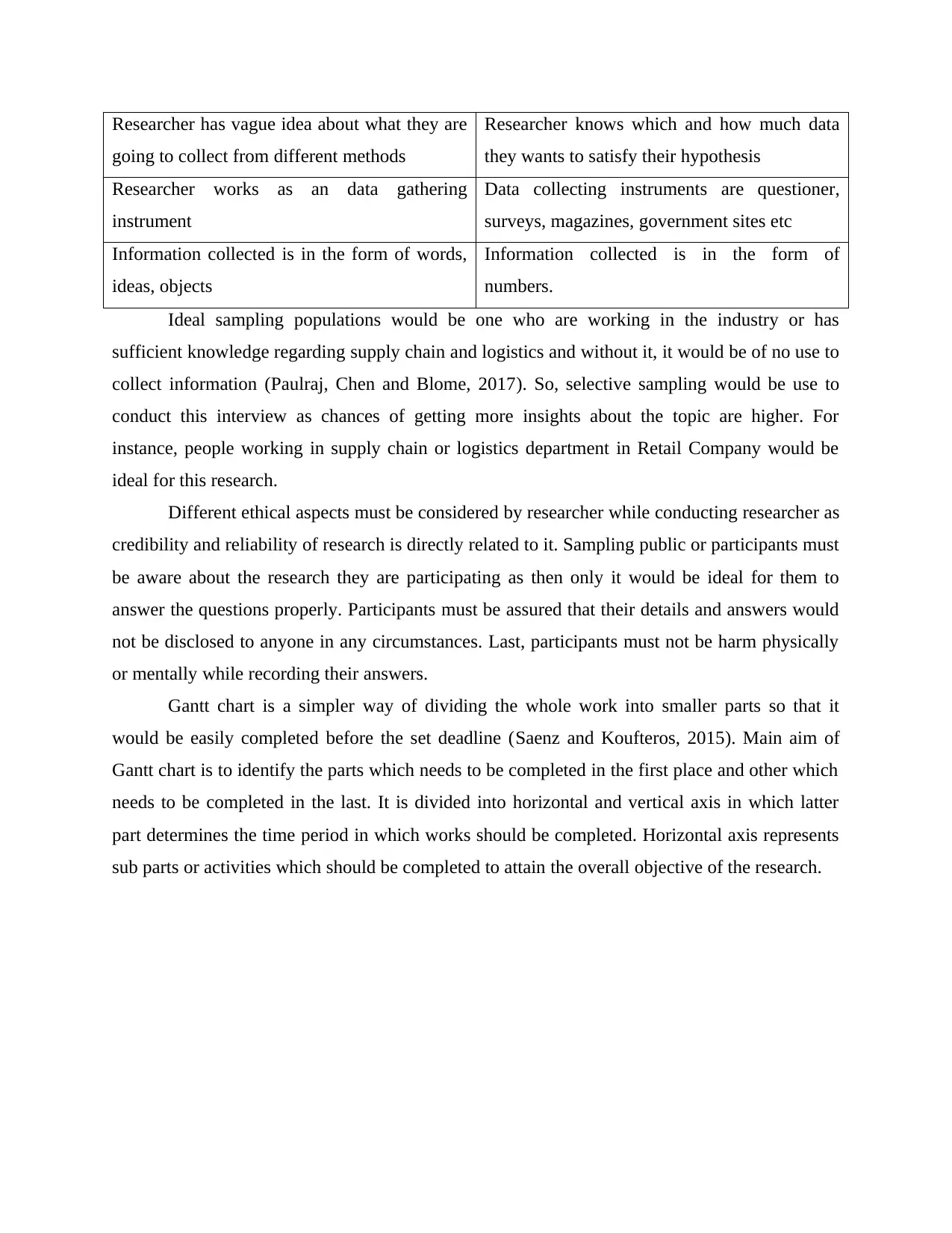
Researcher has vague idea about what they are
going to collect from different methods
Researcher knows which and how much data
they wants to satisfy their hypothesis
Researcher works as an data gathering
instrument
Data collecting instruments are questioner,
surveys, magazines, government sites etc
Information collected is in the form of words,
ideas, objects
Information collected is in the form of
numbers.
Ideal sampling populations would be one who are working in the industry or has
sufficient knowledge regarding supply chain and logistics and without it, it would be of no use to
collect information (Paulraj, Chen and Blome, 2017). So, selective sampling would be use to
conduct this interview as chances of getting more insights about the topic are higher. For
instance, people working in supply chain or logistics department in Retail Company would be
ideal for this research.
Different ethical aspects must be considered by researcher while conducting researcher as
credibility and reliability of research is directly related to it. Sampling public or participants must
be aware about the research they are participating as then only it would be ideal for them to
answer the questions properly. Participants must be assured that their details and answers would
not be disclosed to anyone in any circumstances. Last, participants must not be harm physically
or mentally while recording their answers.
Gantt chart is a simpler way of dividing the whole work into smaller parts so that it
would be easily completed before the set deadline (Saenz and Koufteros, 2015). Main aim of
Gantt chart is to identify the parts which needs to be completed in the first place and other which
needs to be completed in the last. It is divided into horizontal and vertical axis in which latter
part determines the time period in which works should be completed. Horizontal axis represents
sub parts or activities which should be completed to attain the overall objective of the research.
going to collect from different methods
Researcher knows which and how much data
they wants to satisfy their hypothesis
Researcher works as an data gathering
instrument
Data collecting instruments are questioner,
surveys, magazines, government sites etc
Information collected is in the form of words,
ideas, objects
Information collected is in the form of
numbers.
Ideal sampling populations would be one who are working in the industry or has
sufficient knowledge regarding supply chain and logistics and without it, it would be of no use to
collect information (Paulraj, Chen and Blome, 2017). So, selective sampling would be use to
conduct this interview as chances of getting more insights about the topic are higher. For
instance, people working in supply chain or logistics department in Retail Company would be
ideal for this research.
Different ethical aspects must be considered by researcher while conducting researcher as
credibility and reliability of research is directly related to it. Sampling public or participants must
be aware about the research they are participating as then only it would be ideal for them to
answer the questions properly. Participants must be assured that their details and answers would
not be disclosed to anyone in any circumstances. Last, participants must not be harm physically
or mentally while recording their answers.
Gantt chart is a simpler way of dividing the whole work into smaller parts so that it
would be easily completed before the set deadline (Saenz and Koufteros, 2015). Main aim of
Gantt chart is to identify the parts which needs to be completed in the first place and other which
needs to be completed in the last. It is divided into horizontal and vertical axis in which latter
part determines the time period in which works should be completed. Horizontal axis represents
sub parts or activities which should be completed to attain the overall objective of the research.
Paraphrase This Document
Need a fresh take? Get an instant paraphrase of this document with our AI Paraphraser
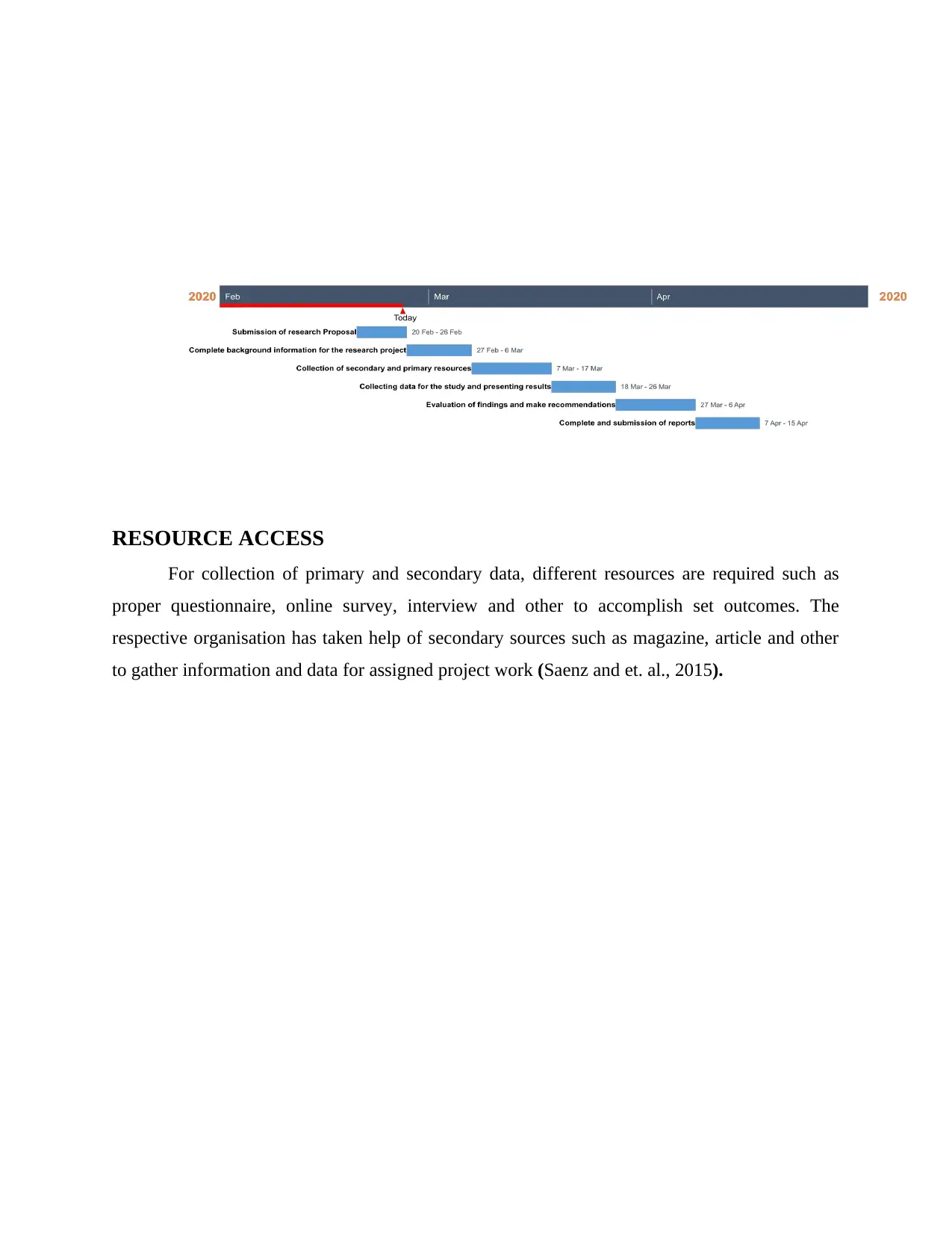
RESOURCE ACCESS
For collection of primary and secondary data, different resources are required such as
proper questionnaire, online survey, interview and other to accomplish set outcomes. The
respective organisation has taken help of secondary sources such as magazine, article and other
to gather information and data for assigned project work (Saenz and et. al., 2015).
For collection of primary and secondary data, different resources are required such as
proper questionnaire, online survey, interview and other to accomplish set outcomes. The
respective organisation has taken help of secondary sources such as magazine, article and other
to gather information and data for assigned project work (Saenz and et. al., 2015).
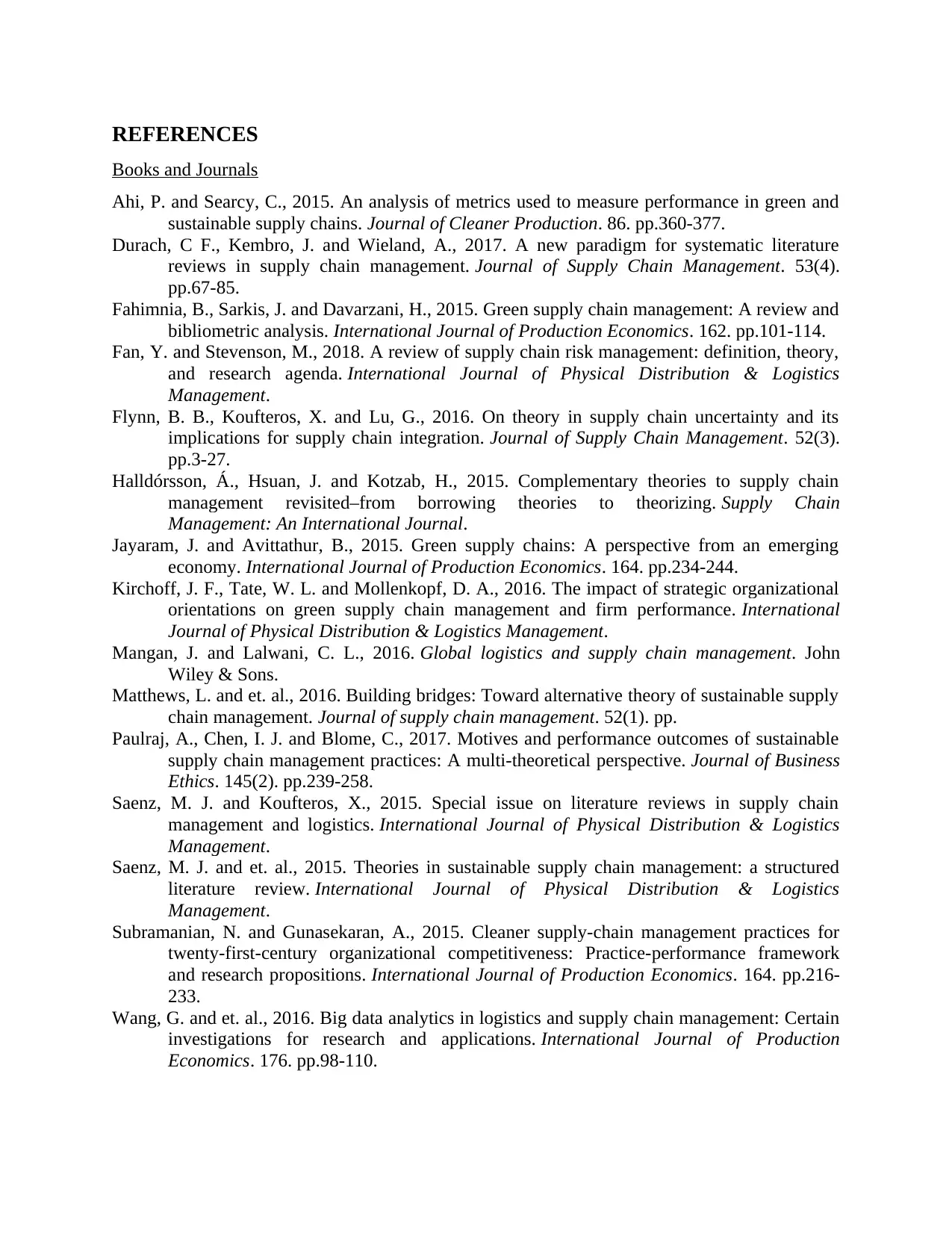
REFERENCES
Books and Journals
Ahi, P. and Searcy, C., 2015. An analysis of metrics used to measure performance in green and
sustainable supply chains. Journal of Cleaner Production. 86. pp.360-377.
Durach, C F., Kembro, J. and Wieland, A., 2017. A new paradigm for systematic literature
reviews in supply chain management. Journal of Supply Chain Management. 53(4).
pp.67-85.
Fahimnia, B., Sarkis, J. and Davarzani, H., 2015. Green supply chain management: A review and
bibliometric analysis. International Journal of Production Economics. 162. pp.101-114.
Fan, Y. and Stevenson, M., 2018. A review of supply chain risk management: definition, theory,
and research agenda. International Journal of Physical Distribution & Logistics
Management.
Flynn, B. B., Koufteros, X. and Lu, G., 2016. On theory in supply chain uncertainty and its
implications for supply chain integration. Journal of Supply Chain Management. 52(3).
pp.3-27.
Halldórsson, Á., Hsuan, J. and Kotzab, H., 2015. Complementary theories to supply chain
management revisited–from borrowing theories to theorizing. Supply Chain
Management: An International Journal.
Jayaram, J. and Avittathur, B., 2015. Green supply chains: A perspective from an emerging
economy. International Journal of Production Economics. 164. pp.234-244.
Kirchoff, J. F., Tate, W. L. and Mollenkopf, D. A., 2016. The impact of strategic organizational
orientations on green supply chain management and firm performance. International
Journal of Physical Distribution & Logistics Management.
Mangan, J. and Lalwani, C. L., 2016. Global logistics and supply chain management. John
Wiley & Sons.
Matthews, L. and et. al., 2016. Building bridges: Toward alternative theory of sustainable supply
chain management. Journal of supply chain management. 52(1). pp.
Paulraj, A., Chen, I. J. and Blome, C., 2017. Motives and performance outcomes of sustainable
supply chain management practices: A multi-theoretical perspective. Journal of Business
Ethics. 145(2). pp.239-258.
Saenz, M. J. and Koufteros, X., 2015. Special issue on literature reviews in supply chain
management and logistics. International Journal of Physical Distribution & Logistics
Management.
Saenz, M. J. and et. al., 2015. Theories in sustainable supply chain management: a structured
literature review. International Journal of Physical Distribution & Logistics
Management.
Subramanian, N. and Gunasekaran, A., 2015. Cleaner supply-chain management practices for
twenty-first-century organizational competitiveness: Practice-performance framework
and research propositions. International Journal of Production Economics. 164. pp.216-
233.
Wang, G. and et. al., 2016. Big data analytics in logistics and supply chain management: Certain
investigations for research and applications. International Journal of Production
Economics. 176. pp.98-110.
Books and Journals
Ahi, P. and Searcy, C., 2015. An analysis of metrics used to measure performance in green and
sustainable supply chains. Journal of Cleaner Production. 86. pp.360-377.
Durach, C F., Kembro, J. and Wieland, A., 2017. A new paradigm for systematic literature
reviews in supply chain management. Journal of Supply Chain Management. 53(4).
pp.67-85.
Fahimnia, B., Sarkis, J. and Davarzani, H., 2015. Green supply chain management: A review and
bibliometric analysis. International Journal of Production Economics. 162. pp.101-114.
Fan, Y. and Stevenson, M., 2018. A review of supply chain risk management: definition, theory,
and research agenda. International Journal of Physical Distribution & Logistics
Management.
Flynn, B. B., Koufteros, X. and Lu, G., 2016. On theory in supply chain uncertainty and its
implications for supply chain integration. Journal of Supply Chain Management. 52(3).
pp.3-27.
Halldórsson, Á., Hsuan, J. and Kotzab, H., 2015. Complementary theories to supply chain
management revisited–from borrowing theories to theorizing. Supply Chain
Management: An International Journal.
Jayaram, J. and Avittathur, B., 2015. Green supply chains: A perspective from an emerging
economy. International Journal of Production Economics. 164. pp.234-244.
Kirchoff, J. F., Tate, W. L. and Mollenkopf, D. A., 2016. The impact of strategic organizational
orientations on green supply chain management and firm performance. International
Journal of Physical Distribution & Logistics Management.
Mangan, J. and Lalwani, C. L., 2016. Global logistics and supply chain management. John
Wiley & Sons.
Matthews, L. and et. al., 2016. Building bridges: Toward alternative theory of sustainable supply
chain management. Journal of supply chain management. 52(1). pp.
Paulraj, A., Chen, I. J. and Blome, C., 2017. Motives and performance outcomes of sustainable
supply chain management practices: A multi-theoretical perspective. Journal of Business
Ethics. 145(2). pp.239-258.
Saenz, M. J. and Koufteros, X., 2015. Special issue on literature reviews in supply chain
management and logistics. International Journal of Physical Distribution & Logistics
Management.
Saenz, M. J. and et. al., 2015. Theories in sustainable supply chain management: a structured
literature review. International Journal of Physical Distribution & Logistics
Management.
Subramanian, N. and Gunasekaran, A., 2015. Cleaner supply-chain management practices for
twenty-first-century organizational competitiveness: Practice-performance framework
and research propositions. International Journal of Production Economics. 164. pp.216-
233.
Wang, G. and et. al., 2016. Big data analytics in logistics and supply chain management: Certain
investigations for research and applications. International Journal of Production
Economics. 176. pp.98-110.
⊘ This is a preview!⊘
Do you want full access?
Subscribe today to unlock all pages.

Trusted by 1+ million students worldwide
1 out of 13
Related Documents
Your All-in-One AI-Powered Toolkit for Academic Success.
+13062052269
info@desklib.com
Available 24*7 on WhatsApp / Email
![[object Object]](/_next/static/media/star-bottom.7253800d.svg)
Unlock your academic potential
Copyright © 2020–2025 A2Z Services. All Rights Reserved. Developed and managed by ZUCOL.





